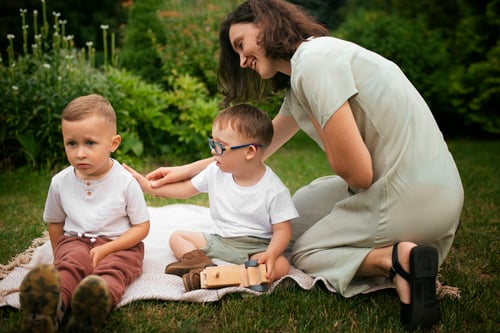Bullying is a worldwide phenomenon that can happen in any setting, including at work and home, but it’s most associated with schools. Studies have shown that up to 25% of school-aged children will experience bullying, and up to 9% of children engage in bullying behaviour at school.
School bullying peaks during middle school years, with a tendency to decrease by the end of high school. However, despite how prevalent bullying is within schools, research has shown that the risk of victimisation is not equal across all students. To find out why, it’s essential to understand what bullying is and why it happens.
What is Bullying?
Many researchers believe that bullying is a result of one central concept: an imbalance of power. This imbalance allows for a divide between individuals, which, in turn, creates opportunities to bully.
An imbalance of power may arise from factors that allow a bully to perceive power over their victim. Power can be in more apparent observable inequalities (such as height and physical strength) or group sizes (three bullies versus one victim). However, other forms of imbalance can derive from an individual’s differentiating factors from the group ‘norm’. Examples include physical appearance, style, learning difficulties and social status.
These differences can manifest in the sense of greater power in a bully over their victim. Subsequently, studies found that when compared to the school population, children who receive special educational assistance or belong to minorities are more likely to experience bullying. Even a perceived imbalance of power can fuel bullying behaviour, which can be as simple as someone’s sense of style being seen as inferior or different from the bully’s norm.
How is Bullying Defined?
For a behaviour to be defined as bullying, researchers have identified three main characteristics: intent, aggression and repetition.
- Intentional: When the bullying behaviour must intend to cause harm to a specific individual
- Aggressive: Not just physical aggression but any form of action that causes damage in a verbal, mental or emotional manner
- Repeated: The behaviour must be persistent (occurring more than once)
So, now that we understand bullying behaviour better, we can examine the different types of bullying behaviours.
What are the 4 Types of Bullying?
Traditional Bullying
Historically, bullying has been physical and verbal:
- Verbal bullying: Includes name-calling, teasing and threatening,
- Physical bullying: Often refers to behaviours that cause physical harm to another, such as punching and scratching.
These forms of bullying are now referred to as ’Traditional Bullying’.
As time progressed, a better understanding of bullying behaviour and the various presented manners became apparent. Hence, the name traditional bullying has come about.
Relational Bullying
Other forms of bullying include ‘Relational Bullying’, which involves indirect and nonphysical types of harm such as spreading rumours, excluding or ignoring individuals and even manipulation.
Cyberbullying (Social Media Bullying)
With the rise of social media, bullying in school has evolved from physical bullying into a more pervasive form known as social media bullying. This type of cyberbullying involves using platforms like Instagram, Facebook, and Twitter to harass, intimidate, or spread harmful content about others. As students move into later primary and early middle school years, there's a shift from traditional bullying to more insidious forms, including social media bullying.
The reach and anonymity of social media make it easier for bullies to target their victims anywhere, anytime, often intensifying the emotional harm. Addressing social media bullying requires awareness and proactive steps from parents, educators, and students to prevent and respond to this growing issue.
Social Bullying
Social or relational bullying involves actions that harm someone’s social connections or reputation. This type of bullying includes spreading rumours, deliberately excluding someone, or embarrassing them in front of others. Social bullying can be subtle but is often just as harmful, affecting the victim’s sense of belonging and self-worth.
The Effects of Bullying
Emotional and Mental Health
One of the most profound effects of bullying is the toll it takes on a student’s emotional and mental health. Victims often experience low self-esteem, anxiety, and social stress, which can lead to more serious issues like depression. The emotional strain is overwhelming and enduring, sometimes lasting well into adulthood. These emotional challenges are often compounded by physical symptoms, such as stomach aches, headaches, and difficulty sleeping, which can further diminish a student’s overall quality of life.
Missing or Skipping Classes
The emotional and psychological burden of bullying often leads students to miss school or skip classes. This avoidance behaviour is a response to the intense social stress and fear associated with being bullied. Unfortunately, frequent absences can significantly hinder academic progress, leading to poor grades and a lack of engagement with schoolwork. Moreover, missing classes further isolates students from their peers, exacerbating feelings of loneliness and exclusion and creating a vicious cycle that deepens the impact of bullying on their academic and social lives.
What Can be Done to Stop or Prevent Bullying?
A lot of research is being dedicated to anti-bullying interventions within schools. Research has shown that school programs that include parents have a more substantial impact on reducing bullying behaviour. Also, programmes encouraging peer support and participation in defending behaviours tend to decrease bullying behaviour within classrooms and social groups.
Importantly, research has also demonstrated that teaching children about empathy can make a big difference. Through learning to empathise with peers and understanding individual differences, students are less likely to fall into an imbalance of power and more likely to support and defend their peers, as well as model pro-social behaviours. Defending behaviours among peer groups is crucial in reducing bullying and increasing social support between peers. This makes it essential to take the time to speak to children about empathy, individual differences and support.
If you believe your child has suffered from bullying in school or cyberbullying, you can reach out to us at MindWorX for professional child psychology assistance in Hong Kong. We work with schools, families, and children to educate them about bullying and harassment.

Rachel Chan Mazariegos
- MSc (UK), BSc (UK)
- RQTU (BPS), MBPsS (BPS)
- ABSNP (US)
- PCBT
- International Affiliate of the American Psychological Association
- Member of the Hong Kong Psychotherapy Society
- Full Membership of the International Neuropsychological Society
Health Articles by Rachel Chan Mazariegos
References
- Farrow, C. V., & Fox, C. L. (2011). Gender differences in the relationships between bullying at school and unhealthy eating and shape-related attitudes and behaviours. British Journal of Educational Psychology, 81(3), 409–420. doi: 10.1348/000709910x525804
- Garandeau, C. F., Vartio, A., Poskiparta, E., & Salmivalli, C. (2016). School bullies’ intention to change behavior following teacher interventions: Effects of empathy arousal, condemning of bullying, and blaming of the perpetrator. Prevention Science, 17(8), 1034–1043. doi: 10.1007/s11121-016-0712-x
- Menesini, E., & Salmivalli, C. (2017). Bullying in schools: The state of knowledge and effective interventions. Psychology, Health & Medicine, 22(sup1), 240–253. doi: 10.1080/13548506.2017.1279740
- Noorden, T. H. J. V., Cillessen, A. H. N., Haselager, G. J. T., Lansu, T. A. M., & Bukowski, W. M. (2016). Bullying involvement and empathy: Child and target characteristics. Social Development, 26(2), 248–262. doi: 10.1111/sode.12197
- Wolke, D., & Lereya, S. T. (2015). Long-term effects of bullying. Archives of Disease in Childhood, 100(9), 879–885. doi: 10.1136/archdischild-2014-306667
 Central General Practice
Central General Practice
 Repulse Bay
Repulse Bay
 Clearwater Bay
Clearwater Bay
 BodyWorX Clinic
BodyWorX Clinic
 Central Specialist Clinic
Central Specialist Clinic
 MindWorX Clinic
MindWorX Clinic
 Partner Clinics
Partner Clinics
 Family Clinic
Family Clinic
 OT&P Annerley Midwives Clinic
OT&P Annerley Midwives Clinic













